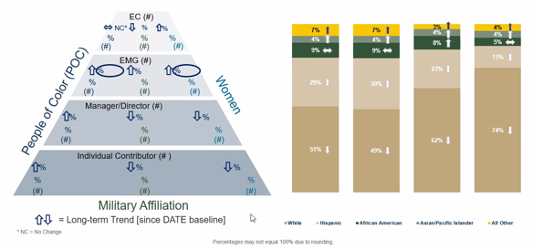
Diversity & Inclusion
CrossLead offers unique expertise to guide our clients through the creation and implementation a Diversity & Inclusion programs. In this presentation, we have organized a simple framework for evaluating and selecting D&I initiatives:
- Part 1: Tailor to the Audience
- Part 2: Data Collection & Analysis
- Part 3: Alignment on Initiatives
CrossLead believes that diversity & inclusion is critical in driving shared consciousness within an organization. We assist our clients with developing inclusive talent programs and aligning leadership teams on priority initiatives.
Part 1
Tailor to the Audience
Diversity and Inclusion Overview
Before launching a D&I program, an organization must consider three core pillars, organized by audience focus. Each pillar requires unique initiatives tailored to the audience in order to lead both inside and outside .
Any D&I journey should begin with Pillar 1, focused on the organization’s workplace.
Pillar 1:
Workplace [Our People]– initiatives are tailored to create a diverse, inclusive, and knowledgeable workforce. Initiatives may include inclusive leadership training programs, dedicated talent acquisition resources to support sourcing and talent pipeline, talent assessment and development, employee engagement, career development, promotion expectations and succession planning, etc.
Pillar 2:
Marketplace [Our Partners] – initiatives may be tailored to clients, investors, partner organizations, and industry associations. ESG (i.e. sustainable investing) and associated scorecards are a trending focus to broadcast their values to the market.
Pillar 3:
Everyplace [Our Community] – initiatives may include strategic philanthropy like community investment and matched-giving campaigns, volunteer opportunities with community partners, and philanthropic funds. Strategic partnerships unlock diverse talent pools for which to recruit from.
Part 2
Data Collection & Analysis
Measuring Diversity Within the Ranks [Quantitative]
At CrossLead, we believe diversity of thought comes from various demographics beyond the tradition D&I categories and metrics. Inclusive organizations should expand their demographic selection beyond gender and racial identities to include categories such as veteran status, residential/regional location, education level, and age.
Once you have the demographics determined, analyze the diversity of your key demographics within each rank (see example below). Then, you’ll want to analyze each demographic’s relative salaries, rate/time of promotions, access to special projects, and exposure to upper management within each rank. You can leverage industry, census, or other outside data to inform diversity goals.

Survey Questions [Qualitative]
In addition to the CrossLead Organizational Performance Assessment (OPA) survey questions, which measures inclusion relative to “shared consciousness,” there are two alternate questions we recommend asking your workforce about diversity and inclusion. See below:
Participants should answer on a sliding scale of
1) Strongly Disagree (2) Disagree (3) Somewhat Disagree (4) Neutral (5) Somewhat Agree (6) Agree (7) Strongly Agree. Measure the percent that answered 6 or 7 relative to everyone else.

Responses